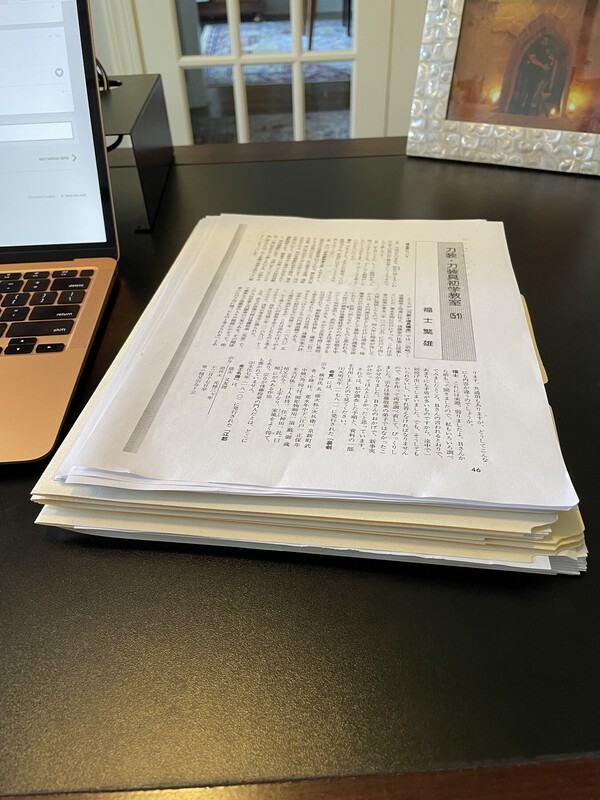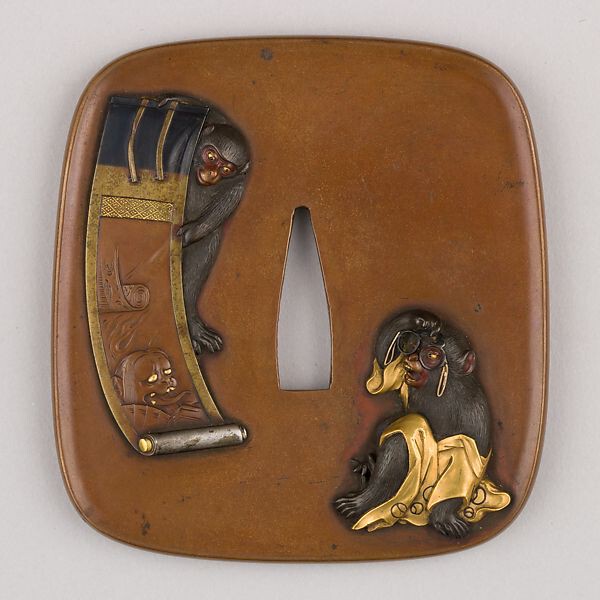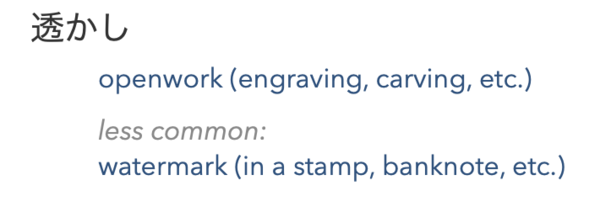-
Posts
948 -
Joined
-
Last visited
-
Days Won
25
Content Type
Profiles
Forums
Events
Store
Downloads
Gallery
Everything posted by Markus
-
Chiming in. The pic below is actually what is left of pure translation work, and that is for all the remaining volumes. All I need, and it sounds so stupid, is to find a good slot to get through everything with Grey and Barry and then finalize the layout and we are all set. Have planned to forward the next installments to Grey and Barry coming week (just cleared another project last week I was working on for two years).
-
This is what I wrote: I think it is actually three characters: Sōyo horu (宗世刀), i.e., “carved by Sōyo.”
-
I have been in touch with the owner, Georg, and discussed the paper with him, but just wanted to add a few clarifying things here as they might be of interest for those who are following this great success story. So as shown, the NBTHK papers the blade Tokubetsu Hozon and adds in parenthesis that it was made around Tenpō ten (天保, 1839), a detail that is based on the workmanship and signature style. Also, the NBTHK verifies the authenticity of the cutting test and states explicitly that it was added by the smith himself, although at a later point in time (obviously). This is pointed out via the expression jishin kiritsuke-mei (自身切付銘). That is, kiritsuke-mei refers to any inscription added after a blade was made, and jishin means "personally," i.e., by the smith himself. As a reminder, if an inscription can not be authenticated and is just acknowledged that it is there, this would be stated so via the suffix to mei ga aru (と銘がある).
-
It is indeed in the catalog. Item No. 12 (wakizashi), p. 32-33.
-

Anyone heard from Markus Sesko?
Markus replied to IJASWORDS's topic in General Nihonto Related Discussion
Hi Les and Mark, and y'all of course. In the meantime, and experimenting with proof copies from Lulu.com, I decided to entirely redo the first two volumes and ship these new ones – at my own expense – to all who have purchased any of the them, including, of course, those who have prepaid for the entire set, and the remaining ones the same way. I know, this all is a nuisance, but I need to get this right going forward, that is, I do not want the print quality being an ongoing issue for me/us years to come. That said, I know that Grey and Barry are kicking their heels to proofread the remaining chapters –which I am working on every single day in any case, and they are accumulating on my end – so I apologize for being such a dinosaur, meaning, I suck badly at switching tasks and my reptile brain can only work off stuff in big batches. Now the broken record is being put on again, but I can promise you that as long as I am alive and not turning into a vegetable, I am working constantly on all outstanding projects as their non-completion does really gnaw on my soul -

Anyone heard from Markus Sesko?
Markus replied to IJASWORDS's topic in General Nihonto Related Discussion
Alive, still. @Neil: I saw that you wrote me a PM and apologize for not having replied (looking at the board on a regular basis, but hardly logging in, and the notifications go to my old email address, so I have to change that). I am still working on the Gendaito Project, but I wish I had met the full goal of donations back then to take that time off to bring the project to the finish line. About 1/4 was met, for which I am very grateful, and after so many years, I totally understand all the frustration, so if anyone wants a refund, I am happy to to do so. I have mentioned at some other occasion that at the moment, and going forward, I am working on what I call my "legacy," which is, newly researched monographs on each of the swordsmith and sword fittings schools published as individual (smaller, and thus less pricy) books. This will not be chronological and I have decided to make the Gendaito Project part of it and publish it as one of the first books in the series. Due to the number of Gendaito smiths, there might even be two volumes, and the website with all the pictorial references that can not go into the book(s) will be there as well. Now working remotely for the museum a full year (and 2,5 years in total), and living in a small town in North Carolina, going back to NYC becomes less and less attractive, also because no decision has been made yet if my position becomes permanent, as Assistant Curator, or not. This means, if that does not work out, and it might be so as it currently appears, I will have full time again to 100% focus on the backlog. -

Dating on Japanese scroll - I've given up
Markus replied to sabiji's topic in Translation Assistance
Yes, meaning and reading/pronunciation is the same. -

Dating on Japanese scroll - I've given up
Markus replied to sabiji's topic in Translation Assistance
Hi Thomas. Long time, no see! The date reads: 昭龢九甲戌年霜月上浣 Shōwa kyū kinoe-inudoshi shimotsuki jōkan "First third of the eleventh month of Shōwa nine (1934), year of the dog." The nengō is written with a very uncommon variant of the WA (和) character (see below). 龢 -
Hi all, It has been a while since the last update on the project, and I sincerely apologize for that, and for the long waiting time as well. Now as per today, translation work is mostly done, that's the good news. I still need to have Grey and Barry proofread the text of course, and for that, I need to find a good time slot, here on my end, as I have to be responsive with corrections, suggestions, and follow-up questions. Grey and Barry work tirelessly, thorough, and quick, so it is totally on me. Other issue: Volume 3 and 4 are the last b/w volumes, that is, I need to have the full layout in front of me for both of them before I can even ship Volume 3. Reason for that is to distribute the content evenly and not ship Volume 3 with 550 pages and then have to cramp everything into an 800 page Volume 4 if you know what I mean. So I might just ship these two volumes together and the color volume shortly after. And this brings us to another, a big issue, and that is print quality. The quality of Lulu and their print partners has even further declined in the last couple of years, especially in Europe (its even slightly worse than with those granular pics from the earlier thread). It is still overall the easiest package in terms of international orders, etc., but at some point, I just have to pull the plug. Means, I am looking for a different venture for a while now and might redo the entire series and re-ship Volume 1 and 2 to those who had ordered them, at my own expense. In any case, the eBooks are perfectly fine and might work as a supplement for some, but if you have paid for the physical books you are getting physical books! Not worming my way out here and just gonna bite the bullet as it is yours truly after all who is responsible for layout and print, etc.
-
Hi all, I will post an update on the project and the issue in a separate and new post. Thank you, Markus
-
This motif is referred to as "oxen released to the peach orchard" (桃林放牛図) or "returning horses, releasing oxen" (帰馬放牛). It goes back to the legend when King Wu of Zhou defeated the Yin, he returned the war horses to the place they were taken from and released the oxen, who had carried war material, to the peach orchard. That way, he was demonstrating the population that the war was over, for good, as horses and oxen for war would never be needed again.
-
Please quote correctly from my books. The Kunimichi (国道) in question has nothing to do with Dewa Daijō Kunimichi (国路) (who just happened to sign with the same characters 国道 in the early years of his career). That's the smith you are looking for: KUNIMICHI (国道), Genroku (元禄, 1688-1704), Iyo – “Yamashiro no Kami Minamoto Kunimichi” (山城守源 国道), he also worked in Yamashiro and carved a chrysanthemum onto his tangs
-
@Brian All good, thank you! Just not much active online lately. @Blagoy No worries at all. Already had two inquiries about this blade in my inbox when I got up, one saying that the blade is also discussed on NMB and if I could take a look at the differences in descriptions. Well, I think it is quite an interesting blade, so here we are Now my take on this is that regardless of school/maker/blade style, everything earlier than mid-Kamakura is by itself quite rare and special, the more if the blade is ubu. Having such an uncommon style here, plus the fact that it is virtually ubu, brings us right into unicorn territory. So what are we facing here? As Kirill pointed out, maybe an (one-time) homage to an ancient blade style? Or an experiment that turned out to be a dead end in terms of functionality (for a long sword), hence very few produced and even less survived? @Rivkin Point [c] I remember seeing a few uncommon blade styles coming from the Ko-Aoe group (or, more precise, with blades that were attributed to Ko-Aoe), i.e., hira-zukuri and shōbu-zukuri on shorter long swords which were not reworked naginata. So, maybe this "eagerness to experiment" played a role in this attribution. In other words, in case an early blade shows Chūgoku region characteristics and has an odd shape, it might go into the Ko-Aoe drawer. But, I am very much armchairing here. Maybe the hada is not as prominent as one would expect from Ko-Hōki. Would be a nice candidate to see in hand.
-
I was pointed towards this thread. Checked the listing, and I hope I can clarify a few things: 1 The Jūyō paper states that the nakago is "almost ubu," although they do not point out what was altered (sometimes they add "just tip was cut off" or "slightly machi-okuri" in parenthesis). The paper also says "dates not later than mid-Kamakura" and "no other examples of such a tsukurikomi for the time period in question." 2. Tanobe sensei says in his sayagaki that the blade is ubu, that it does not date later than early Kamakura, and that "such a tsukurikomi is not only rare for this school [Ko-Aoe] but also rarely seen in blades from other provinces around that time." That is, he is playing it safe, not stating that they do not exist at all. 3. Aoi Art dates the blade on their Japanese site to "end of Heian to early Kamakura period" and indeed state ō-suriage. However, this might just be a website template error (or some other copy and paste error) as they write later down for the blade's characteristics that the blade actually does have an ubu-nakago and is thus an extreme rarity.
-
Thank you very much Ian! I have received a scan of the issue from a friend in Europe who had read this request and who happened to have this issue. I really appreciate your offer to have a staff member of yours scan the copy for me as well!
-
Not sure if this should go in the General section, but is there anyone who can provide me with a scan of Token Bijutsu No. 239 (12/1976)? That would be very much appreciated, and thank you for your attention!
-
I was planning to post a transcript and pics on my site to compensate my lack of clarity, just need to find a minute.
-
While we are on the topic, the Met too has a tsuba which falls into that category. https://www.metmuseum.org/art/collection/search/28616
-
I have my troubles reading everything but this is what I got: 真鍮地 無銘 丸形 径弐寸弐分 両◯ 地◯鉄◯厚味一分二厘 文字、◯模様入 右桃山期太刀金具師 稀品也 昭和五十二年十月吉日 鳥越在耶誌 Shinchū-ji, mumei Marugata, kei ni-sun ni-bu Ryō ? Ji ? tetsu ? atsumi ichi-bu ni-rin Moji, ? moyō hairi Migi Momoyama-ki tachi-kanagu-shi kihin nari Shōwa rokujūninen jūgatsu kichijitsu Torigoe Saro shirusu Brass, unsigned Round shape, diameter ~ 6.7 cm Two ? ? iron ? thickness of ~ 3.5 mm. Has a décor of characters and ? pattern. Above described is a rare tachi-kanagu-shi work from the Momoyama era. Written by Torigoe Saro on a lucky day in October of 1977. As for the third line, I would expect something like "two hitsu(ana)" (両櫃), but as Steve pointed out, the characters that appear to be stated there (両家 or 両字), don't make sense.
-
Hm, I think that this tsuba is actually signed "Matsuyama-jū Shōami Nobutada" (枩山住正阿弥信忠). This would mean that the artist was rather from the Iyo-Shōami than from the Aizu-Shōami group. Nice tsuba BTW.
-
As I just killed my Facebook, I try to be more helpful again here on the NMB.
-
As Grey said, Volume 3 should be out at the end of the year. Regarding the quality issues of Volume 2, I rescanned the ENTIRE series with a new scanner (that I bought just for this project) and different parameters etc., what should eliminate that PDF glitch. Just took about 2h hours off each day of my life for a few months, but yeah, we are getting there
-
Appears to be a "lost in translation" issue I often come across when being approached via "I already ran it through Google translate". Confirming Henry, it is a Bushū (武州) School tsuba with an openwork design (sukashi, 透かし) of the Musashino (武蔵野) motif.







